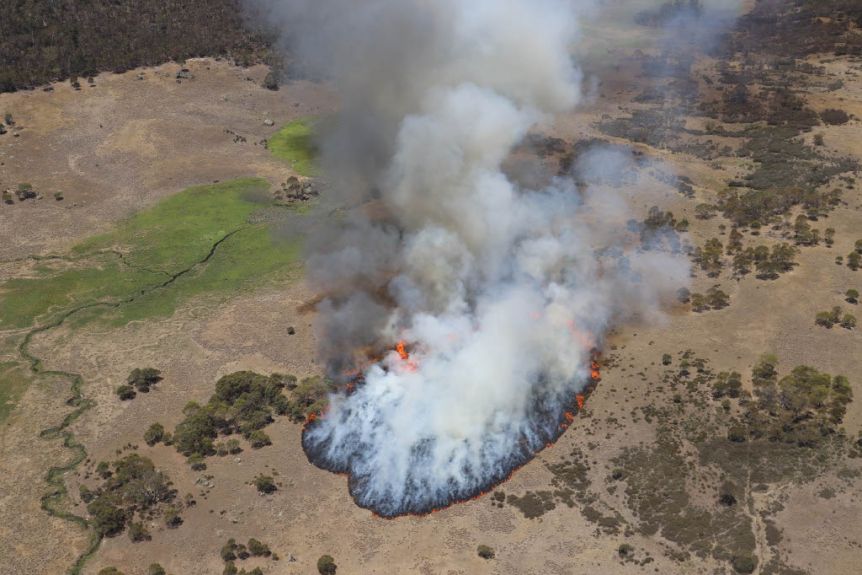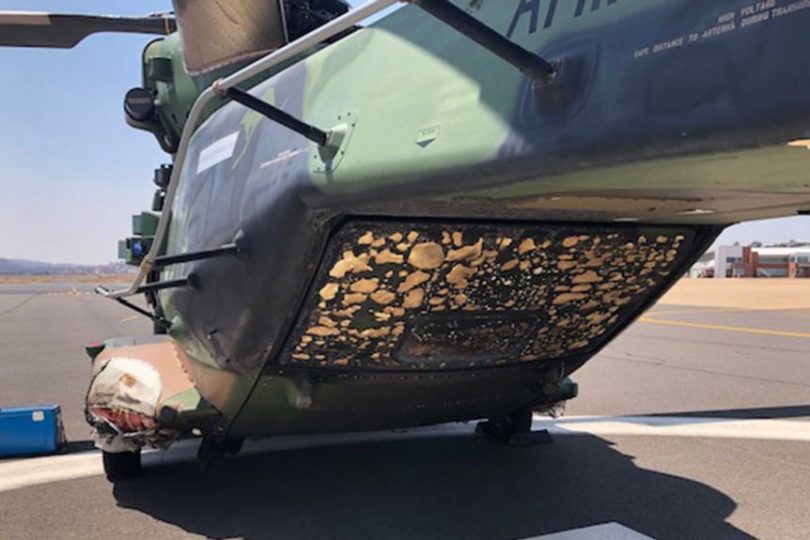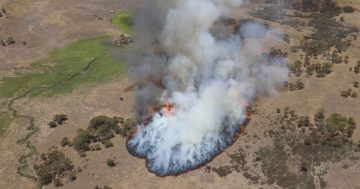
Photos of the start of the Orroral Valley fire taken from the helicopter which accidentally started the blaze. Photo: Department of Defence via ABC.
A serving member of the ADF has revealed the reason why an army helicopter made an unexpected landing the day the Orroral Valley Fire ignited – someone on board needed a “piss break”.
The inquest into the fire began in the ACT Coroners Court on Monday (14 November), with two witnesses questioned by senior counsel assisting Kylie Nomchong SC.
Ms Nomchong outlined that while Defence had accepted “heat from the searchlight caused the fire” on 27 January 2020, the inquiry was examining “when, if at all”, the Army let the ACT Emergency Services Agency (ESA) know helicopter call-sign Angel 21 had ignited a fire in the Namadgi National Park, and if the exact location of the fire was also relayed.
The identity of a number of Defence witnesses were suppressed by the court.
Witness D1 was the co-pilot on the day and was the most senior ranked on board.
That day Angel 21 had been tasked with doing reconnaissance of helicopter landing zones within Namadgi National Park which could be used to deploy rapid response teams should a fire ignite in the area.
On board were two pilots and two aviation crewmen from RAAF Richmond. Two others from 7RAR were picked up from Canberra Airport – one to take photographs and one to take notes.
Witness D1 said while visibility had been good that day, it was his decision to still fly with the searchlight on and in an extended position to support “traffic deconfliction” in the area.
He explained the aircraft was covered in camouflage paint and other planes were in the area.
“We were designed not to be seen in these environments,” D1 said.
“I made the decision to keep the searchlight on and down so we’d be easier to see … try to increase our visual signature as much as possible.
“Whether there’s good visibility or not, [I wanted to] reduce situational awareness bubbles … people can get so focused on the job.”
Ms Nomchong asked whether Witness D1 was aware that the heat from the light was 550 degrees Celsius and that it could get that hot. He replied he did not.
She then questioned whether he knew it could get hot.
“I was never in the location of the searchlight when it was on. I was in the cockpit,” Witness D1 replied.
The court was played a recording from inside the helicopter where about two hours into the flight, someone on board asked, “what are the chances of a whizz break?”
Witness D1 then asked the co-pilot and captain in charge of the aircraft that day, Witness D2, whether they were “authorised to land in these areas” and “have a piss break”.
According to protocol, the aircraft was to declare to 2A, their squadron operations cell, the times and locations when they were ‘wheels up and wheels down’.
However, no such call was made.
When asked why Witness D1 replied: “There were other events unfolding.”

The damage sustained on the helicopter that accidentally ignited the Orroral Valley fire. Photo: Department of Defence via ABC.
It took the aircraft 17 minutes to fly from the Orroral Valley back to Canberra Airport. During that time, no one relayed the information the aircraft had started a fire.
Ms Nomchong challenged Witness D1 about why.
“We were focused on trying to stay alive,” he replied.
“We were quite busy and very uncertain about the aircraft’s state.
“Every step of the way, I was concerned we were going to fall out of the sky.”
Witness D1 said he had reported the fire once they were on ground and out of an “emergency state”.
“It was reported straight away when I was in a position to do so,” he said.
“At the time, the priority was my crew and my aircraft.”
Ms Nomchong put it to Witness D1 the real reason they didn’t say anything was because they didn’t want to damage Defence’s reputation.
“No,” he replied.
He said, in hindsight, they could have “improved” communication with the Air Traffic Control tower.
“[But] I’m very satisfied with the actions of my crew that day,” Witness D1 said.
The co-pilot, Witness D2, was also called to give evidence, and taken through the same recording in more detail, given he was the captain in charge of the aircraft on 27 January 2020.
He said he was aware the searchlight could get hot, however, he wasn’t sure about the “extent” it could create heat.
Witness D2 confirmed while he hadn’t specified the aircraft would land in the Orroral Valley that day, he was approved to make landing decisions.
When it appeared there was a fire, the helicopter was taken to about 10 feet into a hover position to assess any damage to the aircraft.
The court heard as the aircraft took off, Witness D2 said “f*** me” when he saw the fire.
“As we introduced power, the downwash [from the rotor blades] worked as a blow torch,” he said.
“When we came to 10 feet, the flames were at 20 metres.”
Audio of the moment the Angel 21 crew realised they had started a fire in the Orroral Valley on 27 January 2020.
On the recording, the fire was observed to be about 200 by 200 metres, to which Witness D2 responded at the time: “The fire’s a fire. We’ll report that up, guys.”
Witness D2 explained he said that to re-focus the crew on assessing the helicopter.
“My intent was to deal with the fire after, as at that point, we weren’t sure if we were on fire ourselves,” he said.
“At that point, the fire wasn’t an immediate threat to life.”
When questioned why he didn’t make the call to let someone know they had started a fire during the journey back, Witness D2 also defended the decision to stay focused on the aircraft’s status.
“In the triage of things I had going on … [it] was lower on my considerations,” he said.
“The situation was still evolving [and never actually stabilised] … my priority was the safe recovery of the crew and passengers.
“I couldn’t put hand on heart [that] everyone could walk away from the aircraft [safely] until we had landed at Canberra Airport.”
Witness D2 stressed he was ultimately responsible for “everyone not dying at that stage” and that his attention was directed at their “life and death situation”.
“All my other brain space [when not talking with 2A] was dedicated to monitoring the systems in the aircraft,” he said.
The inquest will continue tomorrow (15 November), with Witness D2 back in the witness box.
Original Article published by Claire Fenwicke on Riotact.








